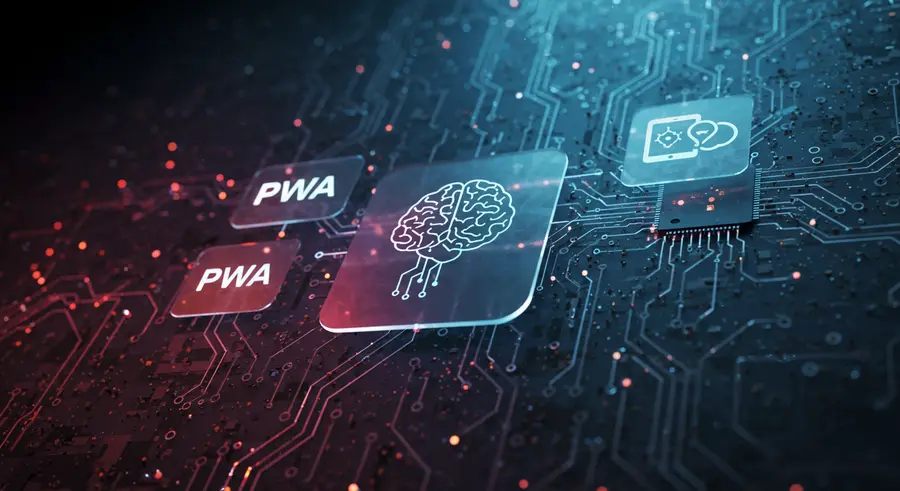Appearance

Welcome, tech innovators! 👋 Today, we're diving deep into the exciting fusion of Progressive Web Apps (PWAs) and Artificial Intelligence (AI), with a special focus on how this powerful combination is revolutionizing offline capabilities. If you thought PWAs were just about app-like experiences and basic offline modes, prepare to be amazed as we explore the intelligent future of web applications!
🌟 The Evolution of PWAs: Beyond Basic Offline
Progressive Web Apps have already transformed how we interact with the web, offering a seamless blend of web and native app features. Their core strengths include:
- Reliability: Thanks to Service Workers, PWAs can cache resources, ensuring lightning-fast loading and reliable access, even on flaky networks or completely offline.
- Installability: Users can "install" PWAs directly to their home screen, providing an app-like icon and experience without the hassle of app store downloads.
- Engage-ability: With features like push notifications, PWAs keep users engaged, delivering timely updates and personalized content.
For a foundational understanding of PWAs, check out our catalogue page: The Power of Progressive Web Apps (PWAs).
🧠 The AI Infusion: Adding Brains to Your PWA
Now, imagine coupling these capabilities with the intelligence of AI. This isn't just about integrating a chatbot; it's about embedding intelligent processing directly into your PWA, especially for scenarios where connectivity is a luxury, not a given. This is where Edge AI truly shines.
What is Edge AI? Edge AI refers to AI processing that happens directly on the user's device (the "edge") rather than in the cloud. For PWAs, this means:
- Real-time Insights: Data can be analyzed instantly without network latency.
- Enhanced Privacy: Sensitive data stays on the device, reducing privacy concerns.
- Reduced Cloud Costs: Less reliance on cloud-based AI services means lower operational expenses.
- Uninterrupted Functionality: AI features remain fully operational even when offline.
💡 How AI Powers Offline PWA Capabilities
Let's explore some compelling examples of how AI, particularly Edge AI, is enhancing offline PWA experiences:
Personalized Content & Recommendations (Offline): Imagine an e-commerce PWA that learns your preferences. With Edge AI, it can analyze your browsing history and purchase patterns locally and provide tailored product recommendations even when you're offline. When connectivity returns, it can sync new preferences or update its models.
- Example: A fashion app suggesting outfits based on your saved styles, even when you're in an area with no signal.
Smart Form Autocompletion & Validation: For forms, an AI-powered PWA can predict user input, validate data, and even suggest corrections in real-time, all without an internet connection. This is invaluable for field service applications, surveys, or data collection in remote areas.
- Example: A medical survey PWA intelligently guiding healthcare workers through data entry, suggesting appropriate responses based on previous inputs.
Natural Language Processing (NLP) for Offline Search: A PWA with an integrated local NLP model can allow users to search through extensive local databases or documentation using natural language queries, providing immediate results.
- Example: A maintenance manual PWA for technicians, allowing voice-activated searches for troubleshooting steps without needing to be online.
Image Recognition and Processing on Device: Edge AI models can perform image analysis directly on the device. This opens up possibilities for object detection, QR code scanning, or even basic facial recognition within a PWA, ideal for inventory management or security applications.
- Example: An inventory PWA for a warehouse, where workers can scan product barcodes with their device camera and get real-time stock information, even during network outages.
Predictive Analytics for Proactive User Experience: By analyzing user behavior patterns offline, an AI-powered PWA can anticipate user needs and proactively adjust its interface or content.
- Example: A fitness PWA that learns your workout routine and proactively suggests the next exercise or rest period based on your previous performance, even if you're exercising in an area without internet access.
🛠️ Building Blocks for Offline AI PWAs
To achieve these advanced capabilities, developers leverage:
- Service Workers: The backbone of PWA offline functionality, intercepting network requests and serving cached content.
- IndexedDB & Cache API: For robust client-side data storage.
- WebAssembly (Wasm): Enables running high-performance code, including AI models, directly in the browser.
- TensorFlow.js / ONNX Runtime Web: Libraries that bring machine learning models to the browser, facilitating Edge AI.
🚀 The Future is Intelligent and Offline-First
The synergy between AI and PWAs is not just a trend; it's the next frontier in web development. As devices become more powerful and AI models become more efficient for edge deployment, we'll see an explosion of intelligent, resilient, and highly personalized web experiences that function flawlessly, regardless of network conditions.
Embrace the future of web development where your applications are not just progressive, but also intelligently aware and always available!
What are your thoughts on AI-powered PWAs and their offline potential? Share your ideas in the comments below! 👇